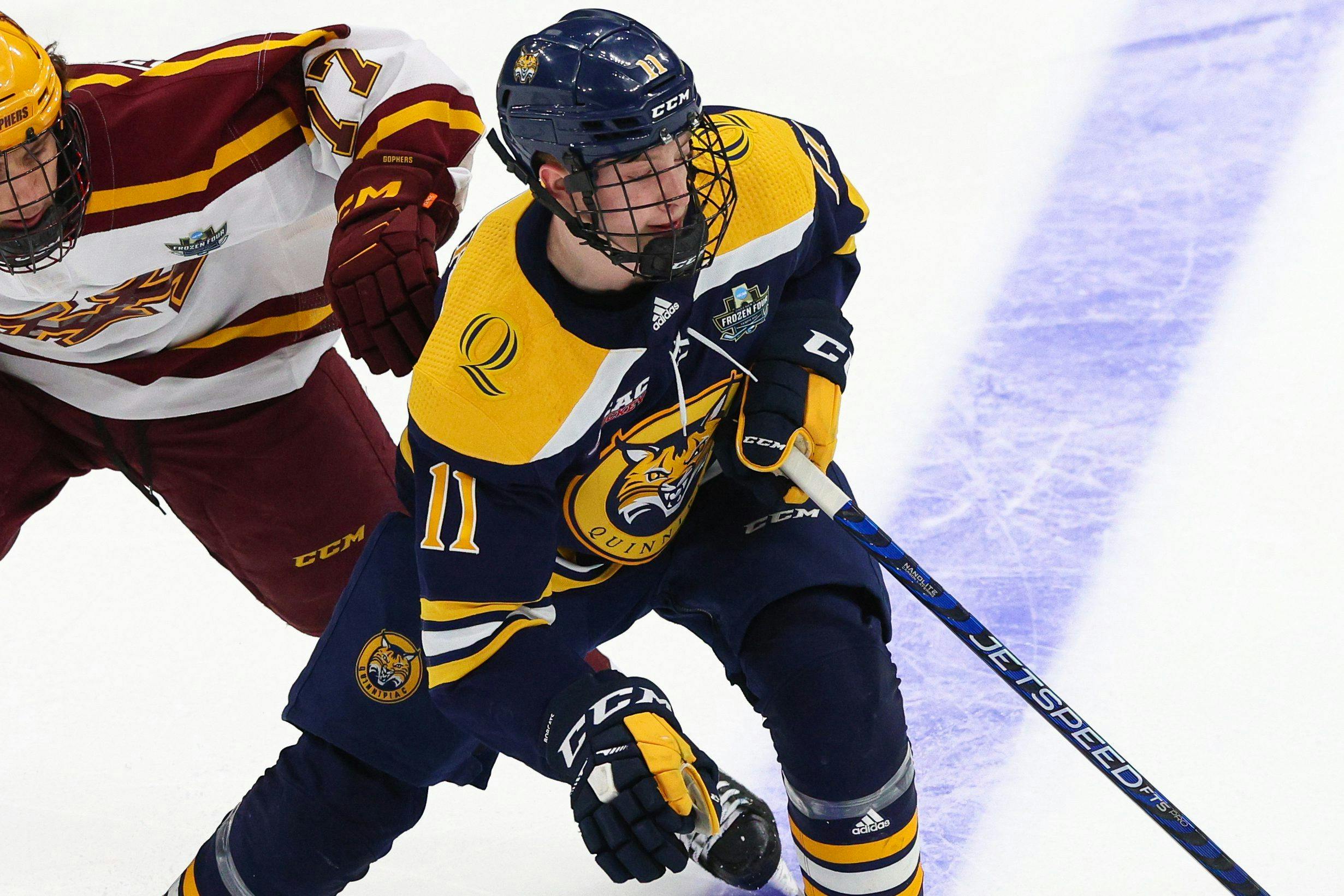NHL Free Agency: Top 10 NCAA UFAs to watch

It’s almost title season, baby.
One of the best parts of the hockey season is the lead-up to the NCAA tournament. More than 60 schools fight each year for the chance to be declared national champions, something won for the first time last year by the Quinnipiac Bobcats out of the ECAC. They knocked off a University of Minnesota team led by Logan Cooley and Matthew Knies, with the Bobcats having just two depth NHL prospects – Arizona’s Sam Lipkin and Carolina’s Charles-Alexis Legault.
College players can’t sign NHL contracts while still in school. But once the season ends, that’s where things get interesting. As exciting as the CHL UFA process is, the college market is even better because players are usually three to four years older with a lot more experience. In theory, they’re more NHL-ready, although it’s more common to find long-term depth pieces than actual hidden gems.
Last year’s top dogs included Jake Livingstone (Nashville Predators), Ryan McAllister (Florida Panthers), Jason Polin (Colorado Avalanche), Sam Malinski (Colorado Avalanche), Akito Hirose (Vancouver Canucks) and Hunter McKown (Columbus Blue Jackets). A few of them have seen NHL duty, with Malinski leading the way with 10 points in 23 games with the Avs this season.
But for the most part, we’re talking about bottom-line/bottom-pairing pickups that cost little and won’t need a long development timeline. That’s where the value comes from out of the NCAA UFA market.
With that in mind, here’s a look at 10 names to know as players start to turn pro over the next few months:
Collin Graf, RW, 21 (Quinnipiac, ECAC)
Graf was among the most highly coveted names a year ago, but after winning the national title with Quinnipiac, he returned to school for another season. It was a good call, with Graf sitting just outside the 50-point mark for the second consecutive year. The 6-foot-1, 194-pound forward has a solid frame, high-level hockey sense and a knack for finishing plays in tight. And at 21, Graf – one of the most productive players over the past two seasons – has displayed a level of maturity that few others his age have. I have no doubt Graf will receive significant attention this year just like he did last spring – I believe he has middle-six potential.
Jacob Quillan, C, 22 (Quinnipiac, ECAC)
Graf’s teammate, Quillan, won’t command the same attention as a junior. But after yet another high-impact season, Quillan is brimming with NHL potential. Quillan scored the title-winning goal a year ago, and it seemed like he never lacked confidence after returning for a third season. He’s likely a bottom-six forward who plays a solid transition game while being a decent penalty-killer, but you need guys like him in your lineup.
Dylan Anhorn, LHD, 24 (St. Cloud State, NCHC)
At 25, Anhorn is the oldest player on the list. The SCS captain set a personal best of 30 points in 34 games, having shown tremendous value as a two-way defenseman over his four-year college tenure that also included two years at Union College. For a player his age, you’d expect someone who can control shifts, and he does it with ease most nights. He’s so competitive, often dominating his own zone with a tremendous level of energy. He’s fully developed at this point and mostly looks like a depth defenseman for an NHL organization at best.
T.J. Hughes, C, 22 (University of Michigan, Big 10)
After an utterly dominant final season with the Brooks Bandits two years ago, Hughes immediately forced himself into a top-six scoring role with the Wolverines and hasn’t disappointed. The goal scorer has 80 points in 75 contests with Michigan, and while he’s had some high-level teammates to work with, Hughes has proven he’s no slouch at the college level. There’s no rush for Hughes to turn pro given he’s just a sophomore, but he has shown enough tenacity and puck skills to suggest he can be a solid pro sooner rather than later.
Victor Östman, G, 23 (Maine, Hockey East)
Östman has become a fan favorite in Maine over the past few years, especially after registering five shutouts as a junior a year ago. His numbers have fallen a bit this season, but he’s 6-foot-4 and doesn’t have any glaring technical deficiencies in his game. If you give him a fresh start with a defensively responsible team, I can see Ostman putting in a few good years in the AHL before earning some backup gigs down the line.
Cooper Black, G, 22 (Dartmouth, ECAC)
At 6-foot-8, Black has the potential to become the biggest goaltender to ever play in the NHL. For that reason alone, I want it to happen. The second-year Dartmouth College goaltender has received attention due to his incredible frame while also doing a lot of heavy lifting for his school this season. He’s not the quickest goaltender, as you’d expect from someone his size, but he stays square to the shot and sees the ice so well. Black has grown so much as a prospect over the past two years, with some scouts seeing him as a potential No. 2 one day.
Carter King, C, 22 (Denver, NCHC)
King has seen significant progression year-to-year with Denver, sitting fourth in scoring with 34 points in 31 games. He plays on both special teams while doing an especially good job as a penalty killer. King is a decent enough skater that can throw some solid hits for a 5-foot-10 forward. If King makes it, it’s because of his tremendous work ethic.
Christian Fitzgerald, C, 21 (Wisconsin, Big 10)
Nothing about Fitzgerald’s numbers this year – 24 points in 36 games – will give teams “wow factor” energy. But I know NHL teams like how hard he competes, and he’s got the high-level skating teams crave from bottom-six forwards. Fitzgerald’s physical game has taken nice steps forward this year, too. I think his lack of production could keep him in school for another year, but a team looking to get his rights early could plunk him in the AHL for a year or two before finding an energy role for him in the future.
Gabriel Seger, LW, 24 (Cornell, ECAC)
The big draw for Seger is his 6-foot-4, 209-pound frame. The Swedish forward has had a pair of good seasons with Cornell, putting up a career-best 12 goals and 35 points this year. Statistically, there’s a lot to like. But from an all-around standpoint, Seger benefited from sticking around as a senior. He’s very smart with the puck, plays a physical game and is a tremendous playmaker. He’s on the older side of the spectrum, but, other than subpar skating, I wouldn’t be surprised if he’s challenging for a bottom-six NHL spot in a couple of years.
Joshua Eernisse, RW, 22 (University of Michigan, Big 10)
I was a bit surprised to see so many scouts tell me about the 22-year-old winger this year, given he has just 13 points in 36 games – a big step down from his 21 points the year before that. In fact, he’s never been one to have significant production anywhere he has played. But from watching him in person, I get it. He’s very physical, moves very well and might be the hardest-working player on the Wolverines. He plays like every shift could be his last, and that type of work ethic goes a long way. He’s not going to produce in the NHL, but teams looking for size and energy can do much worse than signing the 6-foot-3, 205-pound forward.
Other notables: Luke Krys, RHD, 23 (Providence, Hockey East), Zach Bookman, RHD, 21 (Merrimack, Hockey East), Riese Gaber, RW, 24 (North Dakota, NCHC)

Discover Betano.ca – a premium Sports Betting and Online Casino experience. Offering numerous unique and dynamic betting options along with diverse digital and live casino games, Betano is where The Game Starts Now. 19+. Please play responsibly.
Recently by Steven Ellis
- NHL Free Agency: Top 10 CHL UFAs to watch
- 2024 NHL Mock Draft: Celebrini to Blackhawks – then what?
- A scouting report on every notable prospect moved at the 2024 NHL Trade Deadline
- 2024 NHL Draft Rankings: Celebrini, Demidov, Silayev highlight March top 64
- The Pittsburgh Penguins have their deepest prospect pool in years – but there’s still so much work to do
- NHL Prospect Roundup: Buffalo Sabres’ Devon Levi is finding groove in AHL
- March NHL Calder Trophy Update: Connor Bedard hasn’t missed a beat
- Toronto Maple Leafs prospect Easton Cowan is proving doubters wrong
More from Steven Ellis
- Penguins’ goaltending depth has an opportunity to flourish following Tristan Jarry trade
- 2026 World Juniors Preview: Germany just hopes to stick around
- USHL’s Madison Capitols to host “Birds Aren’t Real” night, rebrand to Surveillance Swans
- Former NHL coach Michel Therrien to lead Canada’s 2025 Spengler Cup team
- Pete DeBoer not ruling out NHL coaching job if made available before Olympics